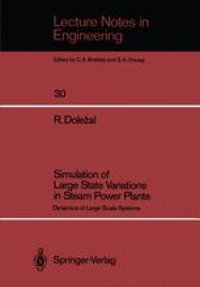
Ebook: Simulation of Large State Variations in Steam Power Plants: Dynamics of Large Scale Systems
Author: Richard Doležal (auth.)
- Tags: Thermodynamics
- Series: Lecture Notes in Engineering 30
- Year: 1987
- Publisher: Springer-Verlag Berlin Heidelberg
- Edition: 1
- Language: English
- pdf
The present simulation method has been developed at the Institute for Power Technology and Steam Generation (IVD) of the University of Stuttgart. It is being successfully employed in the analysis of processes involving large state changes such as start-ups, shut downs, malfunctions and failures in steam power generating unit, which is a large scale system consisting of several subsystems with distributed parameters, to which the steam generator also belongs. This research resulted from the increasing use of the once-through boiler, while simultaneously raising the steam parameters into the region of the supercritical state, using sliding pressure operation, combined processes with gas and steam turbines etc. The objective of this system simulation is to reduce losses of heat and condensate and to minimise unavoidable thermal stresses. The project was financed between 1979 and 1983 by the German Research Society (DFG) as part of the special research section Nr. 157 'Thermal power plants'. The Westfalen Power Company Inc. (VEW) sponsored the start-up code 'DYSTAR'. We would like to express our thanks for this support. The following members of the IVD were involved in this research project: Dr.-Ing. J. Kley Dipl.-Ing. G. Riemenschneider Dr.-Ing. A. Rolf Dipl.-Ing. U. Mayer Dipl.-lng. E. Dr.-lng. M. Klug Pfleger Dr.-Ing. G. Berndt Presently it is intended to use this non-linear, time-variant model of a power generating unit with a variable process and system struc ture as the basis for simple code versions, which one can employ e.g.
This research monograph reports on the development and application of a new algorithm for the simulation of the dynamic behaviour of large-scale thermal systems when large static variations occur. To the latter belong, for example, the starting-up and shutting-down, or the irregular operation of the steam power plant, when a malfunction takes place.The objective of this system simulation is to reduce losses of heat and condensate and to minimize unavoidable thermal stresses.
This research monograph reports on the development and application of a new algorithm for the simulation of the dynamic behaviour of large-scale thermal systems when large static variations occur. To the latter belong, for example, the starting-up and shutting-down, or the irregular operation of the steam power plant, when a malfunction takes place.The objective of this system simulation is to reduce losses of heat and condensate and to minimize unavoidable thermal stresses.
Content:
Front Matter....Pages I-IX
Introduction....Pages 1-4
The Limitations of Process Simulation Using Linearised, Time-Invariant Differential Equations....Pages 5-8
The Dynamic Behaviour of a Two-Flow Heat Exchanger....Pages 9-10
The Algorithm of Analytical Approximation....Pages 11-22
Change of the Inlet Temperature in an Unheated Pipe as an Example of a Disturbance on the Hot Water Flow Side....Pages 23-28
The Decoupled Algorithm....Pages 29-43
Two Flow Heat Exchanger with a One-Phase Compressible Working Medium Flow....Pages 44-48
Two-Phase Flow of the Working Medium....Pages 49-56
The Direction of the Propagation of a Disturbance in a Boiler....Pages 57-65
Model of the Steam Generator and the Power Generating Unit....Pages 66-76
Power Generating Unit Model....Pages 77-79
Starting-Up Process Model....Pages 80-92
Malfunctions and Failures....Pages 93-106
Back Matter....Pages 107-114
This research monograph reports on the development and application of a new algorithm for the simulation of the dynamic behaviour of large-scale thermal systems when large static variations occur. To the latter belong, for example, the starting-up and shutting-down, or the irregular operation of the steam power plant, when a malfunction takes place.The objective of this system simulation is to reduce losses of heat and condensate and to minimize unavoidable thermal stresses.
Content:
Front Matter....Pages I-IX
Introduction....Pages 1-4
The Limitations of Process Simulation Using Linearised, Time-Invariant Differential Equations....Pages 5-8
The Dynamic Behaviour of a Two-Flow Heat Exchanger....Pages 9-10
The Algorithm of Analytical Approximation....Pages 11-22
Change of the Inlet Temperature in an Unheated Pipe as an Example of a Disturbance on the Hot Water Flow Side....Pages 23-28
The Decoupled Algorithm....Pages 29-43
Two Flow Heat Exchanger with a One-Phase Compressible Working Medium Flow....Pages 44-48
Two-Phase Flow of the Working Medium....Pages 49-56
The Direction of the Propagation of a Disturbance in a Boiler....Pages 57-65
Model of the Steam Generator and the Power Generating Unit....Pages 66-76
Power Generating Unit Model....Pages 77-79
Starting-Up Process Model....Pages 80-92
Malfunctions and Failures....Pages 93-106
Back Matter....Pages 107-114
....